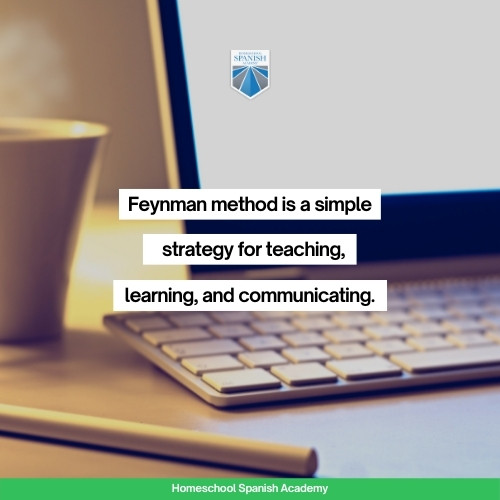
Using the Feynman Technique To Learn a New Language
The Feynman technique is a learning method that aims to simplify concepts and help you understand them better and faster. This method has shown its efficiency in a variety of fields and even has a pop culture reference.
Keep reading to learn what the Feynman technique is, what Tom Hanks and Denzel Washington have to do with it, where it comes from, and how you can apply it to learning anything—from complex science to basic Spanish concepts.
What’s the Feynman Technique?
In 1993, Tom Hanks won the Academy Award for Best Leading Actor for his role as a Philadelphia lawyer with AIDS. A little gimmick of the lawyer he hired to represent him (played by Denzel Washington) has been ingrained in pop culture ever since.
In the movie, the lawyer would ask his clients to “explain it to me like I’m a 6-year-old.” The idea caught on because of its simplicity. However, a technique had been in use for several decades that tried to do just that, in a systematic and comprehensive way: the Feynman technique.
In a nutshell, the Feynman technique or Feynman method is a simple strategy for teaching, learning, and communicating that conveys information in concise and simple language.

See also: 5 Tips to Learn Basic Spanish Faster
Where Does the Feynman Technique Come From?
Although the famous phrase coined by Denzel Washington’s character is catchy, the actual Feynman technique was invented by one of the greatest minds of the 20th century, Nobel Prize-winning physicist Richard Feynman.
The Feynman method of learning is a breakdown of his own personal thought process. Basically, he wrote down the way his mind approached his own learning process and shared it with the world.
How Does It Work?
The Feynman method of studying can be used to quickly learn new concepts, to study more efficiently, and to approach anything new that you want to learn. It focuses on understanding concepts and ideas instead of memorizing them.
For Feynman, the threshold of learning was trying to explain something in simple terms. By doing that, you recognize the areas where you have a thorough understanding of that concept. More importantly, this practice highlights the areas where your understanding isn’t solid, because that’s where you get stuck and resort to complex language and terminology.
So, explain it to me like I’m a 6-year-old.
How to Apply the Feynman Technique
As a simplifying learning method, the Feynman technique is also quite simple to apply. Just follow these 4 steps.
Step 1 – Identify the Topic
Know what you want to learn. Write the topic at the top of a piece of paper and then proceed to study the topic in any way you like. When you’re approaching a topic for the first time, it doesn’t matter how you do it from the Feynman technique perspective.

Now, list everything you know about the subject.
Step 2 – Teach It to a (6-year-old) Child
Verbalize your explanation in terms that a 6-year-old would understand. Don’t use complex terminology and jargon.
Remember that kids have a short attention span, so you need to keep your explanation as brief as possible.
Step 3 – Identify Gaps in Your Explanation
Here is when things get interesting and where the originality of the Feynman technique comes to the front. Now that you have your explanation ready, go through it and look for knowledge gaps. Find spots where you couldn’t avoid using complex vocabulary or where the explanation is shaky.
Study again, go back to your notes, your source material, and other content to fix the comprehension issues.
Step 4 – Organize and Simplify
Once you’ve identified your knowledge gaps, reorganize and simplify your explanation even further. If possible, share your knowledge, tell a story, and communicate your explanation to someone else in a simple, easy-to-understand way.
Use examples, analogies, and comparisons—tools that show your understanding of the topic at hand. Communicating your knowledge helps others learn, and it helps you solidify what you already know.
How to Learn Spanish Faster With the Feynman Technique
The beauty of the Feynman technique is that it serves for learning anything you want, Spanish included. If you can explain a Spanish concept in English, it means that you have a good understanding of it. Of course, if you’re able to explain it in Spanish, you would be going deeper in your understanding.
By using the Feynman technique on Spanish topics, you force yourself to expand your vocabulary and use synonyms and alternative words. What’s more, you learn the Spanish language on a deeper level.
Feynman Technique Example
Let’s apply the Feynman technique to a traditionally hard-to-master concept in Spanish, gender-specific nouns.

Step 1 – Identify the Topic
Write down in bullet points what you know about the topic.
- In Spanish, nouns are gendered
- Most times, feminine nouns end in -a
- Most times, masculine nouns end in -o
- Articles vary according to gender
Step 2 – Teach it to a (6-year-old) Child
In Spanish, all nouns have a gender. The table (la mesa) is a girl, and the telephone (el teléfono) is a boy.
Most of the time, the last letter of the noun suggests its gender. If it’s a, the noun is usually a girl. If the last letter of the noun is o, it’s probably a boy.
Articles vary to reflect the gender of the noun you’re using. By paying attention to them, you can identify the gender of a specific noun.
Step 3 – Identify Gaps in Your Explanation
I actually read my explanation to my 7-year-old daughter and she asked me:
- What is gender?
- What are nouns?
- What are articles?
- How can I know if something is a boy or a girl just by looking at an article (that I don’t even know what it is)?
Step 4 – Organize and Simplify
Once my daughter completely destroyed my explanation and my ego as a teacher, I went back to basics and started from zero:
In Spanish, every object is either a boy or a girl. That’s called “gender.” This table is a girl, and that telephone is a boy. These objects and every other thing or person are known in language as “nouns” or sustantivos in Spanish.
In Spanish, the word table is mesa, and because it ends with the letter a, I know that it’s a girl. In Spanish, the word for telephone is teléfono, and because it ends in o, I know that it’s a boy.
Most times it works like that, and for now that’s all you need to know to understand what gendered nouns are.
In Spanish, every noun comes with an introductory word. That word is la for girls (or feminine nouns) or el for boys (or masculine nouns). These words are called “articles,” and they help you to identify the gender of your noun. The word “table” in Spanish isn’t just mesa, but la mesa. And telephone isn’t only teléfono, but el teléfono. Now you have two ways to know if something is a boy or a girl:
- Looking at the last letter of the word
- Looking at its introductory word
Use the Feynman Technique and Learn Spanish Faster!
Apply these 4 simple steps to every new topic in Spanish to see for yourself how the Feynman technique helps you to understand things better. However, the benefits go further than just understanding individual concepts. By pushing you to explain concepts in Spanish, you’ll make connections with other topics and expand your vocabulary faster.
Learning Spanish brings a lot of benefits to your life: getting cooler jobs, making more money, and improving your cognition and decision-making skills are just a few of them. Sign up today for a free trial class at Homeschool Spanish Academy with one of our certified, native-speaking teachers from Guatemala. They offer flexible scheduling and tailored Spanish packages, and are ready to introduce you to plenty of Spanish topics to which you can apply the Feynman technique!

Join one of the 40,000 classes that we teach each month and you can experience results like these

“This is the best way for your kid to learn Spanish. It’s one-on-one, taught by native Spanish speakers, and uses a curriculum.”
– Sharon K, Parent of 3

“It’s a great way to learn Spanish, from native Spanish speakers in a 1-on-1 environment. It’s been fairly easy to schedule classes around my daughter’s other classes. The best value for us has been ordering multiple classes at a time. All the instructors have been great!”
– Cindy D, Parent of 3

“HSA offers very affordable, quality, one on one classes with a native speaker. My son has greatly benefited from taking classes. We have seen his confidence increase as well as his pronunciation improve, because he learns from a native Spanish speaker. HSA has quick, personal customer service. Our family has been very pleased with our experience so far!”
– Erica P. Parent of 1
Want more free Spanish lessons, fun content, and easy learning strategies? Check these out!
- All You Need to Know About Spanish as a Second Language
- Discover the Joy of Learning Spanish with Summer Fun Activities
- Are Bilingual Children More Likely to Experience a Speech or Language Delay?
- Language Learning with Netflix: How to Use the Chrome Extension
- Turn Your Life Around: From Passive Bilingualism to Fluency!
- The Beauty of Spanish Sign Language
- Multilingual Mastery: How Many Languages Can You Learn?
- The Journey of Becoming Trilingual
- All You Need to Know About Spanish as a Second Language - July 11, 2024
- The Best Homeschool Spanish Curriculum at HSA - June 13, 2024
- 20 Most Common Subjunctive Triggers in Spanish - May 23, 2024





